SERIES 1 – we will cover 3 artists in this blog series.
As the world of art continues to evolve, the spotlight on contemporary Indian artists is shining brighter than ever before. With their innovative approaches, diverse perspectives, and profound insights, these artists born after 1960 are making significant waves not only within India but also on the global stage. From painters pushing the boundaries of traditional techniques to multimedia artists exploring complex social themes, the contemporary Indian art scene is a dynamic tapestry of creativity anRomicon Revola – Visions Art Contemporary Women Artist | Sculptures (visionsarts.com)ces worldwide.
Bharti Kher (Born 1969):
Renowned for her thought-provoking sculptures and installations, Bharti Kher seamlessly blends traditional Indian motifs with contemporary aesthetics. Her iconic work, “The Skin Speaks a Language Not Its Own,” featuring a life-sized elephant adorned with bindis, garnered international acclaim. Kher’s exploration of identity, gender, and mythology resonates deeply with audiences globally, establishing her as a leading voice in contemporary Indian art.

Unveiling the World of Bharti Kher: Beyond Bindis
As an art enthusiast and editor, there’s an excitement that comes with uncovering the layers of an artist’s journey. Bharti Kher, a contemporary force born in 1969 in London, England, has etched her presence into the global art tapestry for nearly three decades, leaving an enduring impression with her thought-provoking creations.
The Bindi Chronicles: A Cultural Reclamation
Kher’s artistic canvas often revolves around the bindi—a seemingly simple dot adorning the forehead, carrying a depth of cultural and spiritual significance. In her hands, this symbol transcends its commonplace portrayal as a mere accessory, becoming a vessel for storytelling and introspection.
In her iconic piece, “The Skin Speaks a Language Not Its Own” (2006), Kher presents a life-sized fiberglass elephant adorned with bindis. This marriage of two cultural symbols—bindis and Hinduism—creates a striking visual narrative, prompting viewers to ponder themes of identity, spirituality, and femininity.
Intermediaries: The Alchemy of Transformation
Transformation is a recurring motif in Kher’s repertoire. She breathes life into mundane materials, infusing them with new meanings and forms. In her “Intermediaries” series, traditional clay figurines meet shards and reconstruction, birthing fantastical hybrids that blur the lines between tradition and innovation.
Take “Virus V” (2014), for instance, where bindis, mahogany wood, and brass converge to form an enigmatic entity. Here, the bindis transcend their decorative role, pulsating with symbolism, inviting viewers to delve deeper into themes of repetition, ritual, and interconnectedness.

Beyond Bindis: Exploring the Boundless
While bindis serve as a cornerstone of her artistic lexicon, Kher’s exploration extends far beyond. In “The Fallow” (2019), a bronze sculpture, she captures the essence of dormancy, echoing the quiet strength found in waiting and renewal. Through materials and metaphors, Kher invites us to question, reflect, and find resonance in the universal rhythms of existence.
In Conclusion: A Journey of Discovery
Bharti Kher’s art transcends geographical and cultural boundaries, offering viewers a window into the complexities of the human experience. Whether through bindis, clay, or bronze, her creations beckon us to listen to their silent narratives—a language shared by all humanity, transcending the constraints of time and place.
I urge you to immerse yourself in Kher’s world, allowing her creations to stir emotions, provoke thoughts, and spark conversations that resonate across borders and generations. In Bharti Kher’s art, we discover not just a reflection of the world, but a profound invitation to explore the depths of our own existence.
Notable Works by Bharti Kher:
“The Skin Speaks a Language Not Its Own”
“An Absence of Assignable Cause”
“Six Women”
More about Bharti Kher
Bharti Kher | Artnet
https://en.wikipedia.org/wiki/Bharti_Kher
https://naturemorte.com/artists/bhartikher/
https://www.hauserwirth.com/artists/2793-bharti-kher/
Subodh Gupta (Born 1964):
Often referred to as the “Damien Hirst of Delhi,” Subodh Gupta’s monumental installations and sculptures challenge perceptions of everyday objects. From stainless steel utensils to bicycles and cow dung, Gupta transforms mundane materials into profound reflections on consumerism, globalization, and cultural identity. His work has been exhibited in prestigious galleries and museums worldwide, solidifying his status as one of India’s most influential contemporary artists.
As an art aficionado, diving into the captivating world of Subodh Gupta is an exhilarating journey. Gupta, a contemporary artist born in 1964 in Khagaul, Bihar, has carved his niche across nearly three decades, imprinting an unforgettable legacy on the global art stage.
From Bihar to Global Reverence: Gupta’s Formative Years
Subodh Gupta’s upbringing in a quaint town laid the groundwork for his artistic prowess. Raised in humble surroundings, Gupta’s childhood was steeped in simplicity and scarcity, instilling in him a profound connection to the earth. His early life anecdotes paint a picture of resilience and resourcefulness, shaping his artistic vision with raw authenticity.
The Artisan of Multifaceted Mastery
Traversing various mediums, Gupta’s artistic odyssey is a kaleidoscope of creativity:
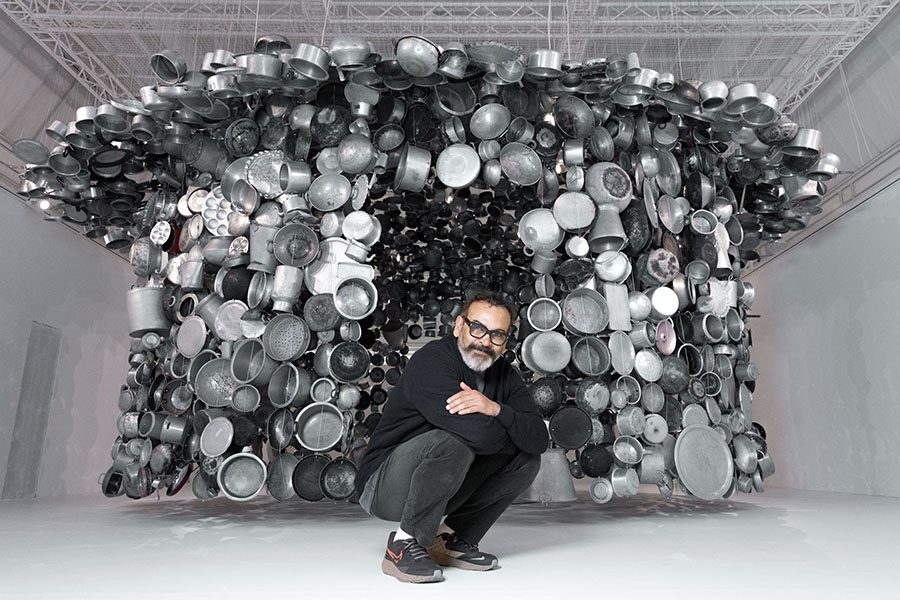
Sculpture: Gupta’s mastery shines through stainless steel, breathing life into everyday objects that define India’s landscape. Pieces like “Very Hungry God” (2006), a colossal skull forged from aluminum kitchenware, catapulted Gupta into international acclaim, reflecting on India’s economic and cultural metamorphosis.
Installation: Gupta’s installations weave compelling narratives, as seen in “People Tree” (2018), a symbiosis of stainless steel vessels forming a tree-like structure. His works poignantly question societal dichotomies, blending tradition with globalization, wealth with poverty.
Painting: Gupta’s canvas mirrors his roots, resonating with motifs that echo his concerns. Breaking boundaries, his art disregards constraints, transcending cultural and economic divides.
Photography and Video: Gupta’s lens captures moments of cultural translation and transformation, bridging continents and inviting contemplation on universal themes.
Global Accolades and Critiques
Gupta’s ascent to prominence was marked by exhibitions at prestigious platforms like the Fukuoka Asian Art Triennale and the Gwangju Biennale. His association with Khoj Studios in Delhi further fueled his artistic evolution. Often likened to the French surrealist Marcel Duchamp, Gupta stands tall among India’s most valuable contemporary artists, gracing lists of the world’s most esteemed creatives.
While lauded for his global impact, Gupta’s work has not been immune to criticism, with some noting repetitive elements. Yet, it is this very diversity and resonance that continue to define Gupta’s enduring legacy in the realm of contemporary art.
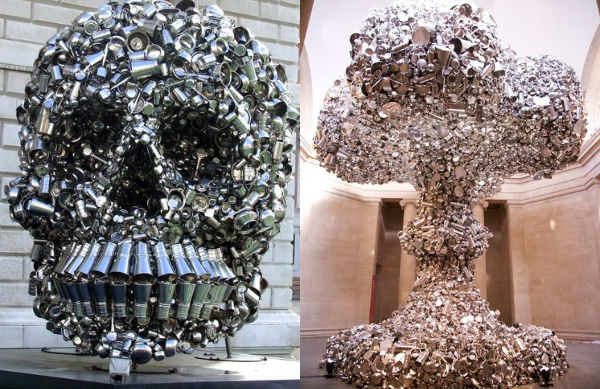
In Conclusion: A Fusion of Art and Identity
Subodh Gupta’s art transcends mere aesthetics, delving into the heart of human experience. From humble beginnings to global reverence, his creations serve as a testament to the transformative power of everyday objects. As we immerse ourselves in Gupta’s world, we’re invited to explore the intersections of tradition and modernity, scarcity and abundance, forging connections that transcend geographical boundaries and cultural divides.
Notable Works by Subodh Gupta
“People Tree” (2018)
“Ray” (2012)
“Cooking the World” (2017)
“Dada” (2013)
More About Subodh Gupta
https://en.wikipedia.org/wiki/Subodh_Gupta
https://www.instagram.com/subodhguptastudio/?hl=en
http://www.subodh-gupta.com/
https://www.artnet.com/artists/subodh-gupta/
Jitish Kallat (Born 1974):
A master of multimedia art, Jitish Kallat seamlessly merges technology with traditional mediums to explore themes of time, history, and urbanization. His iconic installation, “Public Notice,” featuring the speeches of Mahatma Gandhi rendered in LED lights, captivated audiences at the Art Institute of Chicago and the Bhau Daji Lad Museum in Mumbai. Kallat’s visionary approach to storytelling has earned him accolades on the international stage.
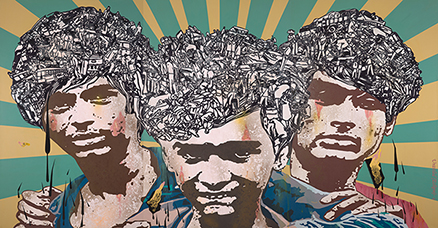
As an art enthusiast, stepping into the immersive universe of Jitish Kallat is akin to embarking on a voyage of discovery—an odyssey that traverses boundaries of time, space, and consciousness. Born in 1974 in Mumbai, India, Kallat’s artistic oeuvre spans mediums and dimensions, weaving intricate narratives that captivate the mind and stir the soul.
A Tapestry of Time: Kallat’s work often serves as a reflection on the passage of time and the impermanence of existence. His iconic installation, “Public Notice,” breathes life into historical speeches of Mahatma Gandhi, rendered in LED lights, transcending temporal boundaries to resonate with contemporary audiences. Through this and other pieces, Kallat invites viewers to contemplate the echoes of the past reverberating in the present moment, urging us to reflect on our shared history and collective aspirations for the future.
Exploring Boundaries: Kallat’s artistic vision knows no bounds, traversing diverse mediums with seamless fluidity. From painting and sculpture to multimedia installations and video art, each creation serves as a portal into the artist’s imagination—a space where boundaries blur and possibilities expand. His interdisciplinary approach challenges conventional notions of artistic expression, inviting viewers to embrace the infinite potential of creativity.
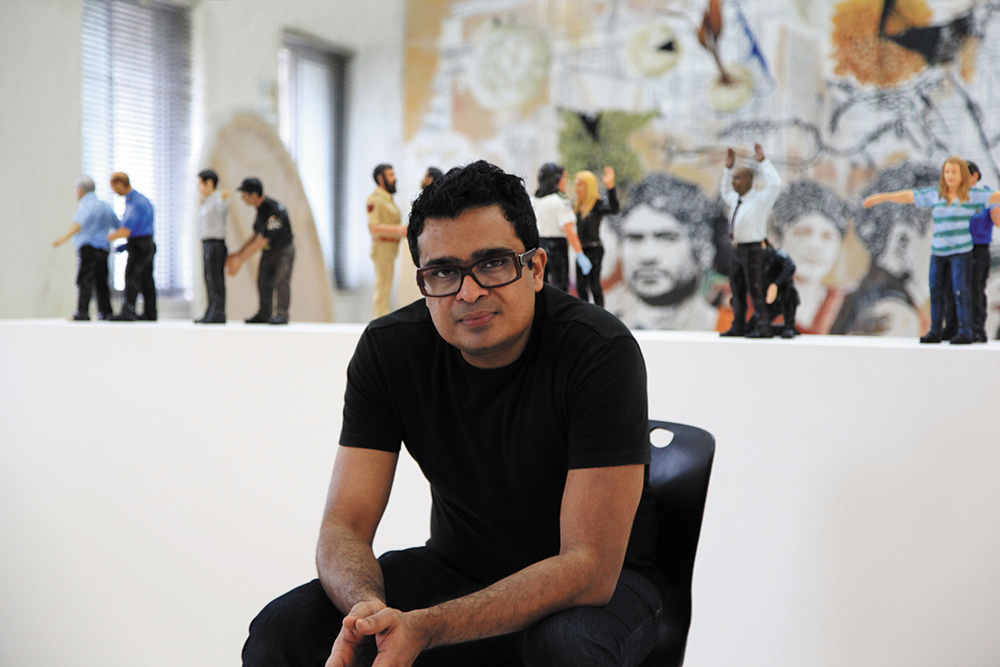
Confronting Complexity: At the heart of Kallat’s work lies a deep engagement with the complexities of the human experience. Themes of identity, migration, and urbanization permeate his art, offering poignant reflections on the myriad forces shaping our world. Through his lens, the chaos of urban landscapes becomes a canvas for introspection, inviting viewers to confront the paradoxes of modern existence and find moments of beauty amidst the chaos.
Dialogues with the Divine: Kallat’s explorations often transcend the material realm, delving into metaphysical inquiries and spiritual quests. His series, “Aquasaurus,” draws inspiration from ancient Indian cosmology, intertwining cosmic narratives with contemporary sensibilities. Through intricate symbolism and allegorical imagery, Kallat invites viewers on a journey through the cosmos, where the boundaries between the mundane and the divine dissolve, and the mysteries of existence unfold.
A Call to Consciousness: Above all, Kallat’s work serves as a call to consciousness—a reminder of our interconnectedness and shared humanity. Through his art, he seeks to provoke dialogue, spark contemplation, and inspire action, inviting viewers to engage with the world around them with newfound clarity and compassion. In a world marked by division and discord, Kallat’s creations serve as beacons of hope, illuminating paths towards understanding and unity.

In Conclusion: Jitish Kallat’s artistic journey is a testament to the transformative power of creativity—a journey that transcends boundaries and expands horizons. Through his evocative creations, he invites us to explore the depths of our collective consciousness, forging connections that bridge past, present, and future. As we immerse ourselves in the enigmatic world of Jitish Kallat, we embark on a voyage of self-discovery—a journey where art becomes a mirror, reflecting the beauty and complexity of the human spirit.
Notable works by Jitesh Kallat
“Public Notice” Series
“All in the Same Boat”
“Degeneration”
More about Jitesh kallat
https://jitishkallat.com/
https://en.wikipedia.org/wiki/Jitish_Kallat
https://www.artsy.net/artist/jitish-kallat
Making waves internationally but also challenging perceptions, sparking conversations, and shaping the future of art on a global scale. As we celebrate their achievements, let us continue to support and champion the rich tapestry of creativity that defines contemporary Indian art.

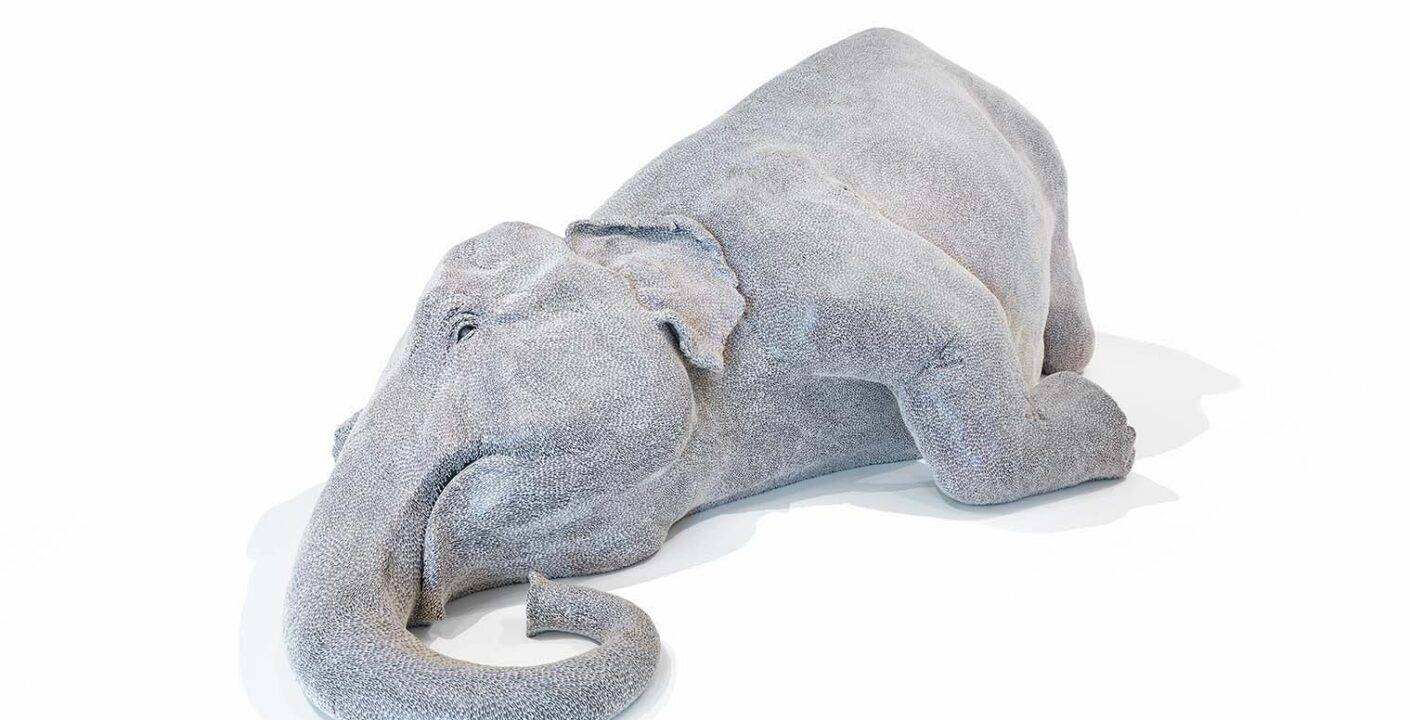
1 Comment
This post does a remarkable job of highlighting the diverse talents and innovative approaches of contemporary Indian artists who are making a significant impact on the international stage. It’s truly inspiring to see how these artists are pushing boundaries and gaining recognition globally. One tip I’d suggest to enhance this already informative post is to consider including more detailed descriptions or anecdotes about specific artworks or exhibitions that have contributed to each artist’s international acclaim. This would provide readers with a deeper understanding of what sets these artists apart and enhance the overall engagement with the content.